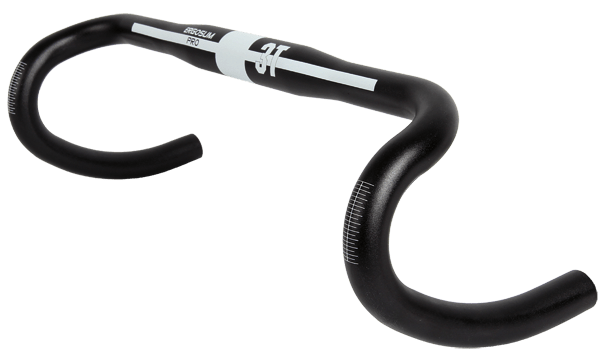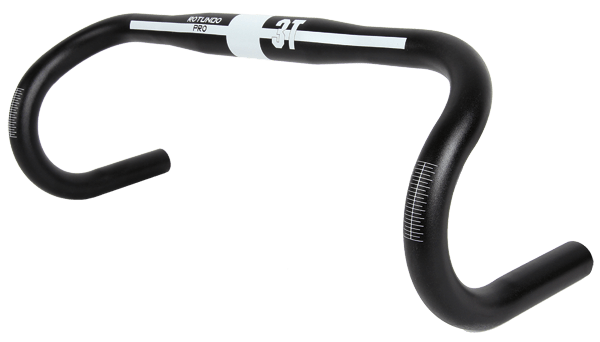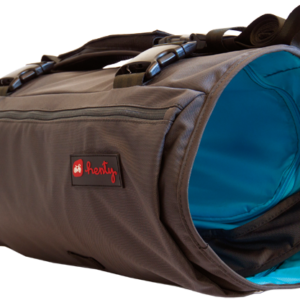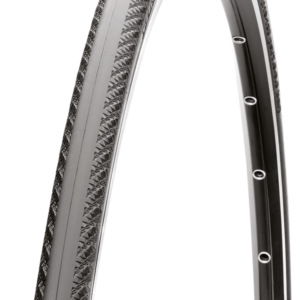 Every drop bar, no matter its age or material, has some traits that make it a drop bar (as opposed to the flat bars of the hybrid or the riser bars of the mountain bike). First there is the bulged or sleeved centre where the stem clamps on. Prior to 20 years ago it was common to find aluminium bars with a second piece of tubing in the middle making the bar fit the stem clamp, but these days even the least expensive alloy bars have a bulge rather than a sleeve (which is great because the two piece bars used to creak terribly). There were three sizes for the bulge: 25.4mm was found on lower priced bikes, 26.0mm was found on most expensive bikes, and 26.4mm was unique to the Cinelli brand. Today you can still find the odd 26.0mm diameter bulge, but almost everything (even MTB bars) has moved up to 31.8mm. There are even some current movements towards 35.0mm as well!
Every drop bar, no matter its age or material, has some traits that make it a drop bar (as opposed to the flat bars of the hybrid or the riser bars of the mountain bike). First there is the bulged or sleeved centre where the stem clamps on. Prior to 20 years ago it was common to find aluminium bars with a second piece of tubing in the middle making the bar fit the stem clamp, but these days even the least expensive alloy bars have a bulge rather than a sleeve (which is great because the two piece bars used to creak terribly). There were three sizes for the bulge: 25.4mm was found on lower priced bikes, 26.0mm was found on most expensive bikes, and 26.4mm was unique to the Cinelli brand. Today you can still find the odd 26.0mm diameter bulge, but almost everything (even MTB bars) has moved up to 31.8mm. There are even some current movements towards 35.0mm as well!
The top section is used for cruising along, for climbing and not a lot else. With modern bar bending (and carbon moulding) technologies the tops can be oval or wing shaped (more aerodynamic and more comfortable for the rider to rest the hands on), raised or drooped, swept back or dead straight and some variations are nearly indescribable. The first point where a real difference is felt in the riding is the forward bend where the tops give way to the drops. This bend can be a large radius that opens up a space for the arm of the rider when gripping the drops (always found on track bars) or it can be a small radius that provides more top space to grip. Many racers bruise their forearms about 12 cm above the wrist while sprinting if this bend is too sharp for their style, especially in the first weeks of using a new bar.

If we look back in time as recently as the early 1980s there were only two styles of drops in common use: the Belgian bend and the Italian bend. These were more alike than they were different. The Belgian bend had a deeper drop while the Italian bend had less. Both had a constant radius curvature to their drop section. These are now called ‘classic’ bends, with the Belgian style considered a deep drop and the Italian style considered a shallow drop. Classic bends are very popular amongst the professional ranks.
Even when all bars were pretty similar there were lots of variations on the same theme with different drops, reaches and widths as well as larger or smaller radius bends between the drops and the tops. Things went crazy with the introduction of anatomic bend bars. There was (and is) no one industry-wide ideal for what a good shape should be.
The one trait that ties most anatomic-style bends together is the sharp angle that begins the downward travel of the drop section. Unlike the classic bars, this tight radius means that small movements of the brake levers result in large changes in the levers’ positioning. While the hoods can range from an upward angle through horizontal to slightly downward without really changing position on the bars (see figs 2-4) the real bonus is that it dramatically affects the reach to the brake lever. Large and small-handed riders can both benefit from this feature.

Which One For You?
There are numerous different bends available from any one company, never mind the variations between companies. With that in mind and with the assistance of 3T, I got one of each of their three different bars to try out and compare. The Rotundo is their classic bend, Ergosum is their anatomic bend, and Ergonova is their anatomic bend with an oval top section.
First off I rode with the Rotundo. I have used an anatomic bar for a very long time, so the one thing I really noticed with this bend was the transition between bar and lever. With the levers set horizontally, the line of the lever top where my hand rests was not straight off the tops of the bars. Rather the shape of these bars means that with the drop section set properly (I always aim the back of the drop at the rear wheel axle) the top sloped downward. For someone with smaller hands than me, this might not be any sort of a problem at all, but with my size 12 mitts, my hand rests on both the bar and lever at the same time while cruising.
I loved the drop section. Long and flat, they were really comfortable to grab onto. The anatomic bars I have been using have a much shorter flat section in comparison. The reach on the Rotundo is quite large so if I grabbed on right at the front of the bar, my wrists hit the bar top when out of the saddle. If I slid my hand rearwards slightly, I could sprint freely.

3T measures these bars as 139mm of drop and 83mm of reach. By old standards these would be shallow bars. As integrated shifters and brake levers have gotten bigger and bigger with each generation, riders have spent more and more time with their hands on the brake hoods and the bars need to be a bit smaller to compensate. The Rotundo has 16mm more drop and 6mm more reach than the Ergonova and 11mm more drop and 6mm less reach than the Ergosum. Many modern bike frames force a long drop from saddle top to bar top, so a really deep drop bar is difficult to use properly. By current standards the Rotundo is a deep drop bar yet it is more Italian than Belgian in the old school thinking.
Next up I installed the Ergosum bars. In comparison to the Rotundo, the sharp radius of the drop permitted dead-flat brake levers coming straight off the tops, just the way I like them. This felt really good out riding. These bars have the longest reach of the three bars tested but even more rearwards projection of the drop section (a characteristic you will not find on the spec sheet). This meant there was plenty of room to hang onto without the tops banging my wrists, but again it was possible to slide my hands far enough forwards to hit my forearms on the tops. The tight bend where the tops go forward was really noticeable on these bars with their shallower drop (shallower than the Rotundo and much shallower than my usual bars). It provided lots of hand room on the tops and extra room on the forward projection, both great features, at the cost of having to have some discipline with where your hands go on the drops for a sprint.
I loved these bars overall. They were just plain comfortable–everywhere. Climbing, descending, sprinting, and cruising all felt great. I did, however, feel that the drop was too shallow for me. Going down on the drops just didn’t lower me as much as I would have liked. Perhaps I would get used to this with more riding time, but in the short span of a review test I never quite got over the feeling that these comparatively shallow drop bars were a tad too shallow for me. In fact riding the Ergosum back-to-back with my usual anatomic bars left me wanting for a hybrid of the two. The deep drop of my own bars with the continuous increasing radius bend of the Ergosum. For me, that would be bar nirvana.
Finally I put on the Ergonova. They appear to be identical to the Ergosum, but as noted above, have less reach and less drop than the Ergosum and less rearward projection too. The drop section is inspired by the same thinking as for the Ergosum. The main difference here is the flat top section that provides more surface area for the rider’s palms and creates another issue regarding bar adjustment – with a round bar no matter how the bar is rotated in the stem, the same surface is presented to the rider. Here a small adjustment in the bar rotation results in an altered feeling when on the tops. For some riders it is impossible to get all the hand positions at the desired angle simultaneously. For me the angle of the flat top and the angle of the drops did work out, but there were times when the flattened section of the top felt a bit awkward. Again this might pass with familiarity.
Most people ride the bars that came on their bike and adapt. That is probably a good thing as the plethora of options out there is confusing. I have long thought that my current bars could be improved upon and now I know that the variable radius bend in the drop is just that improvement. Experience through use is really the only way to know for certain, and a method I heartily endorse for most equipment choices. Whether it is the classic option or the new-school option you choose, 3T and most other bar manufacturers have got you covered.

